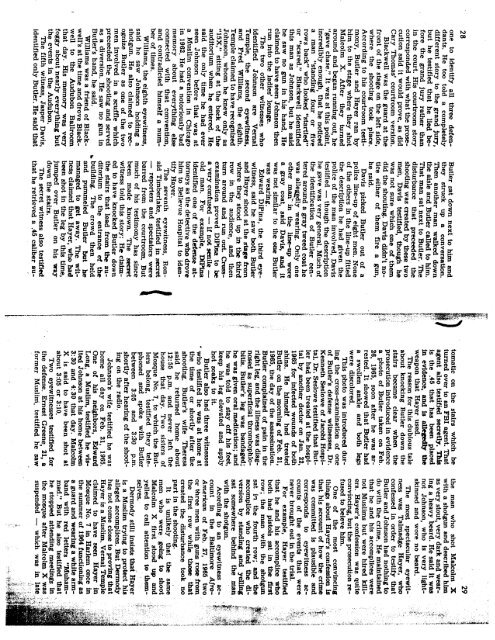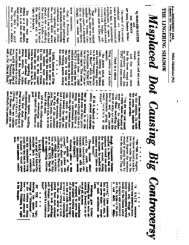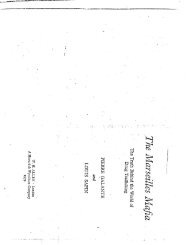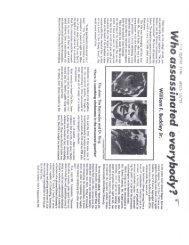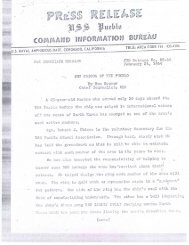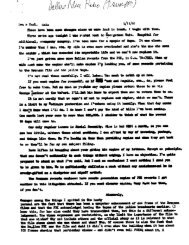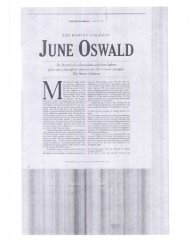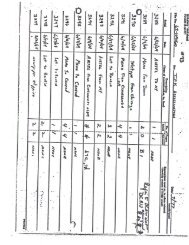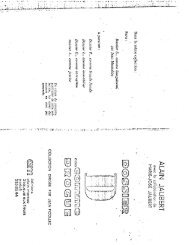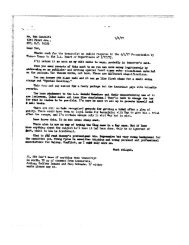THE ASSASSINATION OF MALCOLM X
THE ASSASSINATION OF MALCOLM X
THE ASSASSINATION OF MALCOLM X
Create successful ePaper yourself
Turn your PDF publications into a flip-book with our unique Google optimized e-Paper software.
28<br />
one to identify all three defendants.<br />
He too told a completely<br />
different story to the grand jury,<br />
but he testified that he lied before<br />
the grand jury rather than<br />
in the court. His courtroom story<br />
corresponded with what the prosecution<br />
said it would prove, as did<br />
Cary Thomas' courtroom version.<br />
Blackwell was the guard at the<br />
front of the stage on the left side,<br />
where the shooting took place.<br />
According to his courtroom testimony,<br />
Butler and Hayer ran by<br />
him to the stage where they shot<br />
Malcolm X. After they turned<br />
around and began running out, he<br />
"gave chase." It was at this point,<br />
incredibly enough, that he noticed<br />
a man "standing four or five<br />
rows back" who looked "startled"<br />
or "scared." Blackwell identified<br />
this man as Johnson, but he said<br />
he saw no gun in his hand. He<br />
claimed to have seen Johnson then<br />
run into the ladies' lounge.<br />
The two other witnesses who<br />
identified Johnson are Vernal<br />
Temple, the second eyewitness,<br />
and Fred Williams, the eighth.<br />
Temple claimed to have recognized<br />
Johnson, whom he knew only as<br />
"15X," sitting at the back of the<br />
auditorium when he entered. He<br />
said the only time he had ever<br />
seen Johnson before that was at<br />
a Muslim convention in Chicago<br />
in 1962. He had a notoriously bad<br />
memory about everything else<br />
connected with that convention,<br />
and contradicted himself a number<br />
of times.<br />
Williams, the eighth eyewitness,<br />
said he saw Johnson holding a<br />
shotgun. He also claimed to recognize<br />
Butler as one of the two<br />
men involved in a scuffle which<br />
preceeded the shooting and served<br />
as a diversion. He saw no gun in<br />
Butler's hand, he said.<br />
Williams was a friend of Blackwell's<br />
at the time and drove Blackwell<br />
to the Audubon Ballroom<br />
that day. His memory was very<br />
foggy about nearly everything but<br />
the events in the Audubon.<br />
The fifth witness, Jasper Davis,<br />
identified only Butler. He said that<br />
Butler sat down next to him and<br />
they struck up a conversation.<br />
Then another man walked down<br />
the aisle and Butler called to him.<br />
That man sat next to Butler. The<br />
disturbance that preceeded the<br />
shooting was created by these two<br />
men, Davis testified, though he<br />
was not sure which one of them<br />
did the shouting. Davis didn't notice<br />
either of them fire a gun,<br />
he said.<br />
Davis picked Butler out of a<br />
police line-up of eight men. None<br />
of the others in the line-up fitted<br />
the description he had given the<br />
police of the man involved, Davis<br />
testified — though the description<br />
he gave was very general. Much of<br />
the identification of Butler centered<br />
around a gray tweed coat he<br />
was allegely wearing. Only one<br />
other man- in the line-up wore<br />
a gray coat, said Davis, and it<br />
was not similar to the one Butler<br />
was wearing.<br />
Edward DiPina, the third eyewitness,<br />
said he saw both Butler<br />
and Hayer shoot at the stage from<br />
where they stood up in the third<br />
row in the audience, and then<br />
turn around and run out. Crossexamination<br />
proved DiPina to be<br />
a very confused — if not senile -<br />
old man. For example, DiPina<br />
identified one of the defense attorneys<br />
as the detective who drove<br />
him to Bellevue Hospital to identify<br />
Hayer.<br />
The seventh eyewitness, Ronald<br />
Timberlake, testified in secret<br />
— reporters and spectators were<br />
barred from the courtroom. But<br />
much of his testimony has since<br />
been made known. The secret<br />
witness told this story: He claimed<br />
to have knocked Butler down<br />
the stairs that lead from the auditorium<br />
to the entrance of the<br />
% building. The crowd then held<br />
and pummeled Butler but he<br />
managed to get away. The witness<br />
claimed that Hayer, who had<br />
been shot in the leg by this time,<br />
jumped over Butler on his way<br />
down the stairs.<br />
The secret witness also testified<br />
that he retrieved a .45 caliber au-<br />
tomatic on the stairs which he<br />
turned over to an FBI agent. That<br />
agent also testified secretly. This<br />
is the .45 that has been placed<br />
in evidence, and is allegedly the<br />
weapon that Hayer used.<br />
The reason for this dubious tale<br />
about knocking Butler down the<br />
stairs became clear when the<br />
prosecution introduced in evidence<br />
a photo of Butler taken on Feb.<br />
26, 1965, soon after he was arrested.<br />
It showed that Butler had<br />
a swollen ankle and both legs<br />
were discolored.<br />
This photo was introduced during<br />
the cross-examination of one<br />
of Butler's defense witnesses, Dr.<br />
Kenneth Seslowe of Jacobi Hospital.<br />
Dr. Seslowe testified that Butler<br />
had been treated at the hospital<br />
by another doctor on Jan. 22,<br />
1965 for infected wounds of both<br />
shins. He himself had treated<br />
Butler on the morning of Feb. 21,<br />
1965, the day of the assassination.<br />
Butler complained of pain in the<br />
right leg, and the illness was diagnosed<br />
as superficial thrombophlobitis.<br />
Butler's leg was bandaged;<br />
he was given oral medication; and<br />
he was told to stay off his feet,<br />
keep his leg elevated and apply<br />
hot soaks to it.<br />
Butler also had three witnesses<br />
• who testified he was at home at<br />
the time of or shortly after the<br />
shooting. Butler's wife Theresa<br />
said he returned home about<br />
12:55 p.m. and never left the<br />
house that day. Two sisters of<br />
Mosque No. 7, to which the Butlers<br />
belong, testified they telephoned<br />
and spoke with Butler<br />
between 3:05 and 3:30 p.m.<br />
shortly after hearing of the shooting<br />
on the radio.<br />
Johnson's wife testified he was<br />
home all day on Feb. 21, 1965.<br />
One of his neighbors, Edward<br />
Long, a Muslim, testified he visited<br />
Johnson at his home between<br />
3:30 and 4:30 that day. Malcolm<br />
X is said to have been shot at<br />
about 3:05 or 3:10.<br />
Two eyewitnesses testified for<br />
the defense. Ernest Greene, 21, a<br />
former Muslin, testified he saw<br />
29<br />
the man who shot Malcolm X<br />
with a shotgun and described him<br />
as very stout, very dark and wearing<br />
a heavy beard. He said it was<br />
not Johnson, who is very lightskinned<br />
and wore no beard.<br />
The most spectacular eyewitness<br />
was Tahnadge Hayer, who<br />
confessed in order to testify that<br />
Butler and Johnson had nothing to<br />
do with the crime. He maintained<br />
that he and his accomplices were<br />
not Muslims but were hired killers.<br />
Hayer's confession was quite<br />
convincing, but the prosecution refused<br />
to beieve him.<br />
One of the most convincing<br />
things about Hayer's confession is<br />
that his account of how the crime<br />
was committed is plausible and<br />
corresponds to eyewitness accounts<br />
of the events that were<br />
never brought out in the trial.<br />
For example, Hayer testified<br />
that he and his accomplice who<br />
both had pistols sat in the first<br />
row; the man with the shotgun<br />
sat in the fourth row; and the<br />
accomplice who created the diversion<br />
by standing and yelling<br />
sat somewhere behind the man<br />
with the shotgun.<br />
Acording to an eyewitness account<br />
in the Baltimore Afro-<br />
American of Feb. 27, 1965 two<br />
or three men with guns rose from<br />
the first row while these that<br />
created the disturbance took no<br />
part in the shooting.<br />
It is unlikely that the same<br />
men who were going to shoot<br />
Malcolm X first stood up and<br />
yelled to call attention to themselves.<br />
Dermody still insists that Hayer<br />
is a Muslim trying to protect his<br />
alleged accomplices. But Dermody<br />
has not come close to proving that<br />
Hayer is a Muslim. Vernal Temple<br />
claimed to have seen Hayer in<br />
Mosque No. 7 in Harlem once in<br />
the summer of 1964 functioning as<br />
a guard and wearing a white armband<br />
with red letters "Muhammad."<br />
But he also testified that<br />
he stopped attending meetings in<br />
the mosque after Malcolm X was<br />
suspended — which was in late


